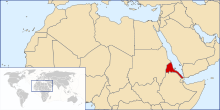- Eritrean cuisine
-
 Kitcha fit-fit is a staple of Eritrean cuisine. It consists of shredded, oiled, and spiced bread, often served with a scoop of fresh yogurt and topped with berbere (spice).
Kitcha fit-fit is a staple of Eritrean cuisine. It consists of shredded, oiled, and spiced bread, often served with a scoop of fresh yogurt and topped with berbere (spice).
Eritrean cuisine is a fusion of Eritrea's native culinary traditions, and the area's long history of trade and social interchanges with other regions and cultures.
Contents
Overview
The main traditional food in Eritrean cuisine is tsebhi (stew) served with injera (flatbread made from teff, wheat, or sorghum), and hilbet (paste made from legumes, mainly lentil, faba beans). Eritrean and Ethiopian cuisine (especially in the northern half) are very similar, given the shared history of the two countries.
Eritrean cuisine strongly resembles those of neighboring Ethiopia and Somalia, except for the fact that Eritrean and Somali cooking tend to feature more seafood than Ethiopian cuisine on account of their coastal locations.[1]
Common foods and dishes
Eritrean food habits vary regionally. In the highlands, injera is the staple diet and eaten daily among the Tigrinya. Injera is made out of a variation and/or blend of: teff, wheat, barley, sorghum and corn and resembles a spongy, slightly sour pancake. When eating, diners generally share food from a large tray placed in the centre of a low dining table. Numerous injera are layered on this tray and topped with various spicy stews. Diners break into the section of injera in front of them, tearing off pieces and dipping them into the stews.
The stews that accompany injera are usually made from beef, chicken, mutton or vegetables. Most Eritreans, with the exception of the Saho, like their food hot and spicy. Berbere, a spice mixture that consists of a variety of common and unusual herbs and spices, accompanies almost all dishes. Stews include zigni, which is made of beef, dorho tsebhi which is made of chicken, alicha which is made without berbere, and shiro, a puree of various legumes. Due to its past as an Italian colony, Eritrean cuisine also features unique interpretations of classic Italian dishes,[2] such as pasta dishes spiced with berbere.[3]
In the lowlands, the main dish is akelet, a porridge-like dish made from wheat flour dough. A ladle is used to scoop out the top, which is filled with berbere and butter sauce and surrounded by milk or yogurt. A small piece of dough is broken and then used to scoop up the sauce.
Beverages
 An Eritrean woman at a traditional coffee ceremony.
An Eritrean woman at a traditional coffee ceremony.
Suwa is the name for the homebrewed beer common in Eritrea. It is made from roast corn, barley, and other grain and flavored with Gesho, a type of buckthorn leaf. It is often made for celebrations. A sweet honey wine is also common. The coffee ceremony is one of the most recognizable parts of Arab, Eritrean and Ethiopian culture. Coffee is offered when visiting friends, during festivities, or as a daily staple of life. If coffee is politely declined then most likely tea (shai) will be served.
References
- ^ Pamela Goyan Kittler, Kathryn Sucher, Food and culture, (Cengage Learning: 2007), p.214.
- ^ "Man Bites World, Day 64: Eritrea". March 2009. http://manbitesworld.com/articles/74/day-64-eritrea. Retrieved 2009-03-22.
- ^ "Mu'ooz Eritrean Restaurant menu". March 2009. http://www.muooz.com.au/?page=98. Retrieved 2009-03-22.
External links
African cuisine National cuisines - Algeria
- Angola
- Benin
- Botswana
- Burkina Faso
- Burundi
- Cameroon
- Cape Verde
- Centrafrican (Central African Republic)
- Chad
- Comoros
- The Republic of the Congo
- The Democratic Republic of the Congo
- Egypt
- Eritrea
- Ethiopia
- Gabon
- Ghana
- Ivorian (Côte d'Ivoire)
- Kenya
- Libya
- Madagascar
- Morocco
- Mozambique
- Namibia
- Nigerien (Niger)
- Nigerian
- Rwanda
- Senegal
- Sierra Leone
- Somalia
- South Africa
- Sudan
- Swaziland
- Tanzania
- Tunisia
- Uganda
- Zambia
- Zimbabwe
Ethnic and regional cuisines  Eritrea topics
Eritrea topicsHistory Geography Politics Economy Agriculture · Energy · Tourism · Eritrean nakfa · Communications · Companies · Transport · Trade unions · HealthDemographics Culture Portal 
This African cuisine-related article is a stub. You can help Wikipedia by expanding it.


